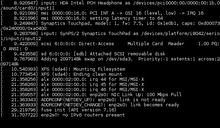
Back لينكس ليبرا Arabic Linux-libre BAR লিনাক্স-লিব্রে Bengali/Bangla Linux-libre Catalan Linux-libre Czech Linux-libre German Linukso-libera Esperanto Linux-libre Spanish لینوکس-لیبره Persian Linux-libre Finnish
 Freedo the penguin, mascot of the Linux-libre kernel | |
 Linux-libre kernel 3.0.66-1 booting | |
| Original author(s) | Linus Torvalds et al. |
|---|---|
| Developer(s) | Free Software Foundation Latin America |
| Initial release | February 20, 2008[1] |
| Stable release | 6.9.6-gnu[2] |
| Repository | |
| Written in | C and Assembly |
| Platform | x86-64, i386, IA-32, ARM (Parabola), MIPS (Debian), m68k,[3] RISC-V,[4] IBM POWER8 and above[5] |
| Available in | English |
| Type | Kernel |
| License | GPL-2.0-only[6] |
| Website | www |
According to the Free Software Foundation Latin America, Linux-libre is a modified version of the Linux kernel that contains no binary blobs, obfuscated code, or code released under proprietary licenses.[7] In the Linux kernel, they are mostly used for proprietary firmware images. While generally redistributable, binary blobs do not give the user the freedom to audit, modify, or, consequently, redistribute their modified versions. The GNU Project keeps Linux-libre in synchronization with the mainline Linux kernel.[8]
- ^ blag-announce (February 20, 2008). "[blag-devel] linux-libre". Archived from the original on November 4, 2023. Retrieved May 25, 2020.
- ^ "6.9.6-gnu". June 21, 2024. Retrieved June 27, 2024.
- ^ "Index of /pub/linux-libre/freesh/dists/freesh/main/binary-m68k". linux-libre.fsfla.org. Retrieved October 5, 2020.
- ^ "Index of /pub/linux-libre/freesh/dists/freesh/main/binary-riscv64". linux-libre.fsfla.org. Retrieved February 7, 2019.
- ^ "Index of /pub/linux-libre/freesh/dists/freesh/main/binary-ppc64el". linux-libre.fsfla.org. Retrieved February 7, 2019.
- ^ "Linux-libre - Free Software Directory".
- ^ "Linux-libre - Free Software Directory". directory.fsf.org. Archived from the original on November 4, 2023. Retrieved September 23, 2022.
- ^ Red, Ramces (March 22, 2022). "5 Best Linux-Libre Distributions for Better Security". Make Tech Easier. Archived from the original on April 30, 2022. Retrieved April 30, 2022.